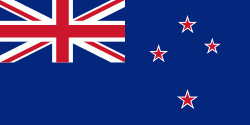Snells Beach (Snells Beach)
Snells Beach is a small coastal town in the north of Auckland Region in the North Island of New Zealand. It is situated on the eastern coast of the Mahurangi Peninsula and its namesake beach faces east across Kawau Bay to Kawau Island. The nearest town is Warkworth, 8 km to the west, which is linked by 8 buses a day and also Mahu City Express twice a day.
Cornish miner James Snell arrived in Kawau in 1854 and bought land, known as Long Beach. Dalmatian immigrants lived in tents on the beach and dug for kauri gum at low tide. Māori called the neighbouring Algies Bay 'horahora wai', meaning encroaching waters. Scottish immigrant Alexander Algie and wife Mina, née Deerness, bought the land near Martins Bay, where his brother Samuel settled in 1867. The family ran a boarding house on the beach during the late 1890s, which closed in 1941. A metal road was built along the eastern peninsula in the 1930s.
In 2012, the Snells Beach library was marked for closure, leaving many residents bewildered and angry. In 2013, water from Snells Beach was needed for Warkworth's water supply.
Cornish miner James Snell arrived in Kawau in 1854 and bought land, known as Long Beach. Dalmatian immigrants lived in tents on the beach and dug for kauri gum at low tide. Māori called the neighbouring Algies Bay 'horahora wai', meaning encroaching waters. Scottish immigrant Alexander Algie and wife Mina, née Deerness, bought the land near Martins Bay, where his brother Samuel settled in 1867. The family ran a boarding house on the beach during the late 1890s, which closed in 1941. A metal road was built along the eastern peninsula in the 1930s.
In 2012, the Snells Beach library was marked for closure, leaving many residents bewildered and angry. In 2013, water from Snells Beach was needed for Warkworth's water supply.
Map - Snells Beach (Snells Beach)
Map
Country - New_Zealand
 |
 |
| Flag of New Zealand | |
The islands of New Zealand were the last large habitable land to be settled by humans. Between about 1280 and 1350, Polynesians began to settle in the islands and then developed a distinctive Māori culture. In 1642, the Dutch explorer Abel Tasman became the first European to sight and record New Zealand. In 1840, representatives of the United Kingdom and Māori chiefs signed the Treaty of Waitangi, which in its English version declared British sovereignty over the islands. In 1841, New Zealand became a colony within the British Empire. Subsequently, a series of conflicts between the colonial government and Māori tribes resulted in the alienation and confiscation of large amounts of Māori land. New Zealand became a dominion in 1907; it gained full statutory independence in 1947, retaining the monarch as head of state. Today, the majority of New Zealand's population of 5.1 million is of European descent; the indigenous Māori are the largest minority, followed by Asians and Pacific Islanders. Reflecting this, New Zealand's culture is mainly derived from Māori and early British settlers, with recent broadening of culture arising from increased immigration. The official languages are English, Māori, and New Zealand Sign Language, with the local dialect of English being dominant.
Currency / Language
| ISO | Currency | Symbol | Significant figures |
|---|---|---|---|
| NZD | New Zealand dollar | $ | 2 |
| ISO | Language |
|---|---|
| EN | English language |















